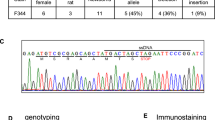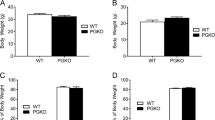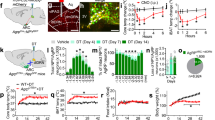Abstract
Members of the muscarinic acetylcholine receptor family (M1–M5) have central roles in the regulation of many fundamental physiological functions1,2. Identifying the specific receptor subtype(s) that mediate the diverse muscarinic actions of acetylcholine is of considerable therapeutic interest, but has proved difficult primarily because of a lack of subtype-selective ligands3. Here we show that mice deficient in the M3 muscarinic receptor (M3R-/- mice) display a significant decrease in food intake, reduced body weight and peripheral fat deposits, and very low levels of serum leptin and insulin. Paradoxically, hypothalamic messenger RNA levels of melanin-concentrating hormone (MCH), which are normally upregulated in fasted animals leading to an increase in food intake4,5, are significantly reduced in M3R-/- mice. Intra-cerebroventricular injection studies show that an agouti-related peptide analogue lacked orexigenic (appetite-stimulating) activity in M3R-/- mice. However, M3R-/- mice remained responsive to the orexigenic effects of MCH. Our data indicate that there may be a cholinergic pathway that involves M3-receptor-mediated facilitation of food intake at a site downstream of the hypothalamic leptin/melanocortin system and upstream of the MCH system.
This is a preview of subscription content, access via your institution
Access options
Subscribe to this journal
Receive 51 print issues and online access
$199.00 per year
only $3.90 per issue
Buy this article
- Purchase on Springer Link
- Instant access to full article PDF
Prices may be subject to local taxes which are calculated during checkout




Similar content being viewed by others
Accession codes
References
Brown, J. H. & Taylor, P. in The Pharmacological Basis of Therapeutics 9th edn (eds Hardman, J. G. et al.) 141–160 (McGraw-Hill, New York, 1996).
Wess, J., Buhl, T., Lambrecht, G. & Mutschler, E. in Comprehensive Medicinal Chemistry, Vol. 3 (ed. Emmett, J .C.) 423–491 (Pergamon, Oxford, 1990).
Caulfield, M. P. Muscarinic receptors—characterization, coupling and function. Pharmacol. Ther. 58, 319–379 (1993).
Qu, D. et al. A role for melanin-concentrating hormone in the central regulation of feeding behaviour. Nature 380, 243–247 (1996).
Shimada, M., Tritos, N. A., Lowell, B. B., Flier, J. S. & Maratos-Flier, E. Mice lacking melanin-concentrating hormone are hypophagic and lean. Nature 396, 670–674 (1998).
Levey, A. I., Edmunds, S. M., Heilman, C. J., Desmond, T. J. & Frey, K. A. Localization of muscarinic M3 receptor protein and M3 receptor binding in rat brain. Neuroscience 63, 207–221 (1994).
Hamilton, S. E. et al. Disruption of the m1 receptor gene ablates muscarinic receptor-dependent M current regulation and seizure activity in mice. Proc. Natl Acad. Sci. USA 94, 13311–13316 (1997).
Gomeza, J. et al. Pronounced pharmacologic deficits in M2 muscarinic acetylcholine receptor knockout mice. Proc. Natl Acad. Sci. USA 96, 1692–1697 (1999).
Gomeza, J. et al. Enhancement of D1 dopamine receptor-mediated locomotor stimulation in M4 muscarinic acetylcholine receptor knockout mice. Proc. Natl Acad. Sci. USA 96, 10483–10488 (1999).
Rogers, P. & Webb, G. P. Estimation of body fat in normal and obese mice. Br. J. Nutr. 43, 83–86 (1980).
Flier, J. & Maratos-Flier, E. Obesity and hypothalamus: Novel peptides for new pathways. Cell 92, 437–440 (1998).
Elmquist, J. K., Elias, C. F. & Saper, C. B. From lesions to leptin: hypothalamic control of food intake and body weight. Neuron 22, 221–232 (1999).
Schwartz, M. W., Woods, S. C., Porte, D. Jr, Seeley, R. J. & Baskin, D. G. Central nervous system control of food intake. Nature 404, 661–671 (2000).
Matsui, M. et al. Multiple functional defects in peripheral autonomic organs in mice lacking muscarinic acetylcholine receptor gene for the M3 subtype. Proc. Natl Acad. Sci. USA 97, 9579–9584 (2000).
Levey, A. I. Immunological localization of m1–m5 muscarinic acetylcholine receptors in peripheral tissues and brain. Life Sci. 52, 441–448 (1993).
Eglen, R. M., Hegde, S. S. & Watson, N. Muscarinic receptor subtypes and smooth muscle function. Pharmacol. Rev. 48, 531–565 (1996).
Crawley, J. N. & Paylor, R. A proposed test battery and constellations of specific behavioral paradigms to investigate the behavioral phenotypes of transgenic and knockout mice. Horm. Behav. 31, 197–211 (1997).
Boschero, A. C. et al. Oxotremorine-m potentiation of glucose-induced insulin release from rat islets involves M3 muscarinic receptors. Am. J. Physiol. 268, E336–E342 (1995).
Gong, D. W. et al. Lack of obesity and normal response to fasting and thyroid hormone in mice lacking uncoupling protein-3. J. Biol. Chem. 275, 16251–16257 (2000).
Bittencourt, J. C. et al. The melanin-concentrating hormone system of the rat brain: an immuno- and hybridization histochemical characterization. J. Comp. Neurol. 319, 218–245 (1992).
Sakurai, T. et al. Orexins and orexin receptors: a family of hypothalamic neuropeptides and G protein-coupled receptors that regulate feeding behavior. Cell 92, 573–585 (1998).
Elias, C. F. et al. Chemically defined projections linking the mediobasal hypothalamus and the lateral hypothalamic area. J. Comp. Neurol. 402, 442–459 (1998).
Broberger, C., De Lecea, L., Sutcliffe, J. G. & Hökfelt, T. Hypocretin/orexin- and melanin-concentrating hormone-expressing cells form distinct populations in the rodent lateral hypothalamus: relationship to the neuropeptide Y and agouti gene-related protein systems. J. Comp. Neurol. 402, 460–474 (1998).
Elias, C. F. et al. Leptin differentially regulates NPY and POMC neurons projecting to the lateral hypothalamic area. Neuron 23, 775–786 (1999).
Mystkowski, P. et al. Hypothalamic melanin-concentrating hormone and estrogen-induced weight loss. J. Neurosci. 20, 8637–8642 (2000).
Rossi, M. et al. A C-terminal fragment of Agouti-related protein increases feeding and antagonizes the effect of alpha-melanocyte stimulating hormone in vivo. Endocrinology 139, 4428–4431 (1998).
Bayer, L., Risold, P. Y., Griffoond, B. & Fellmann, D. Rat diencephalic neurons producing melanin-concentrating hormone are influenced by ascending cholinergic projections. Neuroscience 91, 1087–1101 (1999).
Zeng, F., Hopp, A., Soldner, A. & Wess, J. Use of a disulfide cross-linking strategy to study muscarinic receptor structure and mechanisms of activation. J. Biol. Chem. 274, 16629–16640 (1999).
Kleiber, M. in The Fire of Life 2nd edn 179–222 (R. E. Krieger, Huntington, New York, 1975).
Parkes, M. W. & Parks, J. C. Supersensitivity of salivation in response to pilocarpine after withdrawal of chronically administered hyoscine in the mouse. Br. J. Pharmacol. 46, 315–323 (1972).
Acknowledgements
This research was supported by the JSPS Research Fellowship Program (M.Y.) and through a CRADA between the NIDDK and the Eli Lilly Research Laboratories (B.X.). We thank M. L. Reitman, H. Kodama, H. Kanki and T. Sakurai for advice and discussions; J. Gan, N. Tsujino and C. Li for technical assistance; R. A. Kesterson for critical reading of the manuscript; and A. M. Spiegel and I. W. Levin for support of this work.
Author information
Authors and Affiliations
Corresponding author
Rights and permissions
About this article
Cite this article
Yamada, M., Miyakawa, T., Duttaroy, A. et al. Mice lacking the M3 muscarinic acetylcholine receptor are hypophagic and lean. Nature 410, 207–212 (2001). https://doi.org/10.1038/35065604
Received:
Accepted:
Issue Date:
DOI: https://doi.org/10.1038/35065604
This article is cited by
-
A preliminary study of the effects of an antimuscarinic agent on anxious behaviors and white matter microarchitecture in nonhuman primates
Neuropsychopharmacology (2024)
-
Muscarinic control of cardiovascular function in humans: a review of current clinical evidence
Clinical Autonomic Research (2024)
-
Iris color and day–night changes in the sympathovagal ratio
Sleep and Biological Rhythms (2023)
-
Acetylcholine prioritises direct synaptic inputs from entorhinal cortex to CA1 by differential modulation of feedforward inhibitory circuits
Nature Communications (2021)
-
In vivo cardiopulmonary impact of skeletal M3Dq DREADD expression: a pilot study
Journal of Comparative Physiology B (2021)
Comments
By submitting a comment you agree to abide by our Terms and Community Guidelines. If you find something abusive or that does not comply with our terms or guidelines please flag it as inappropriate.



